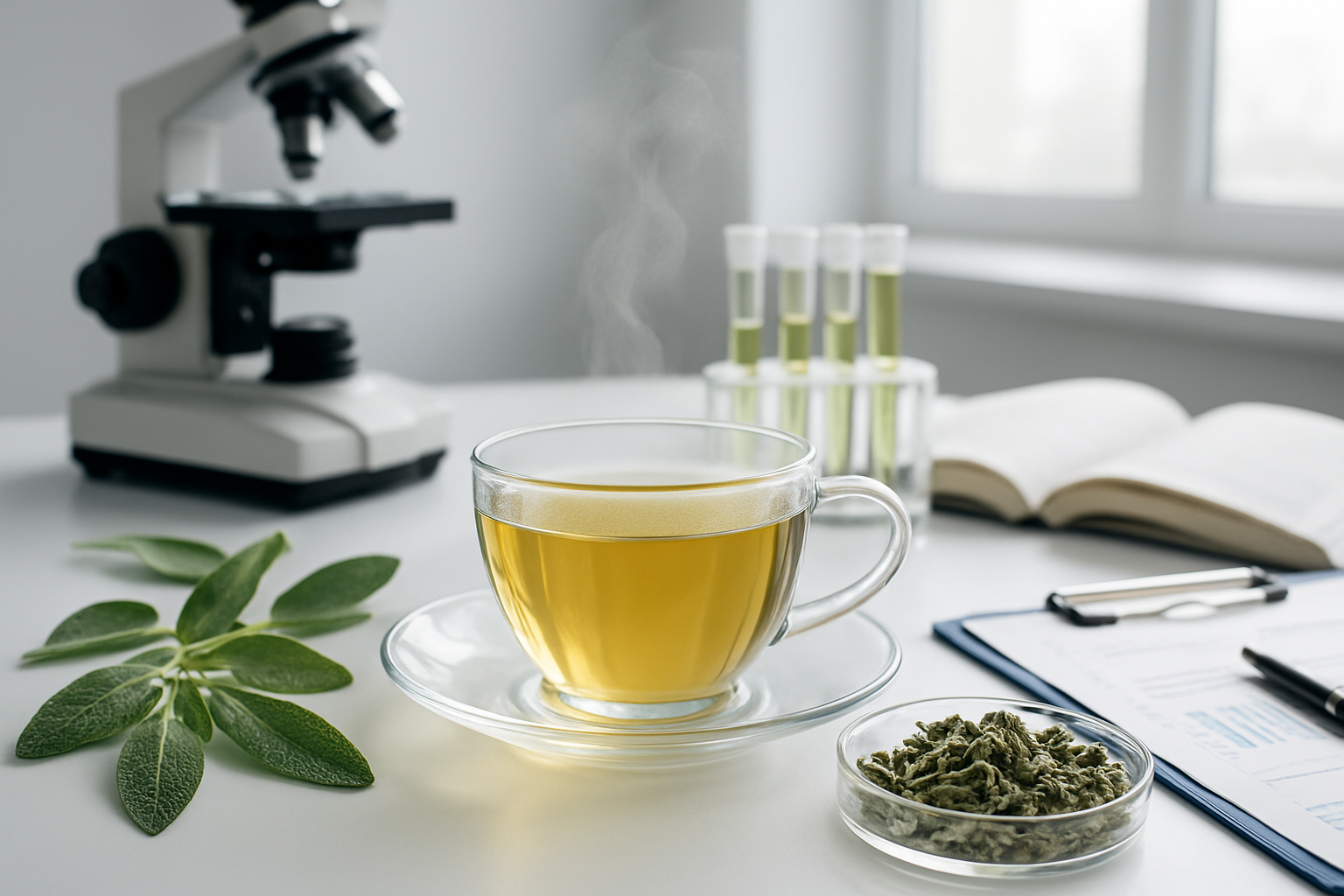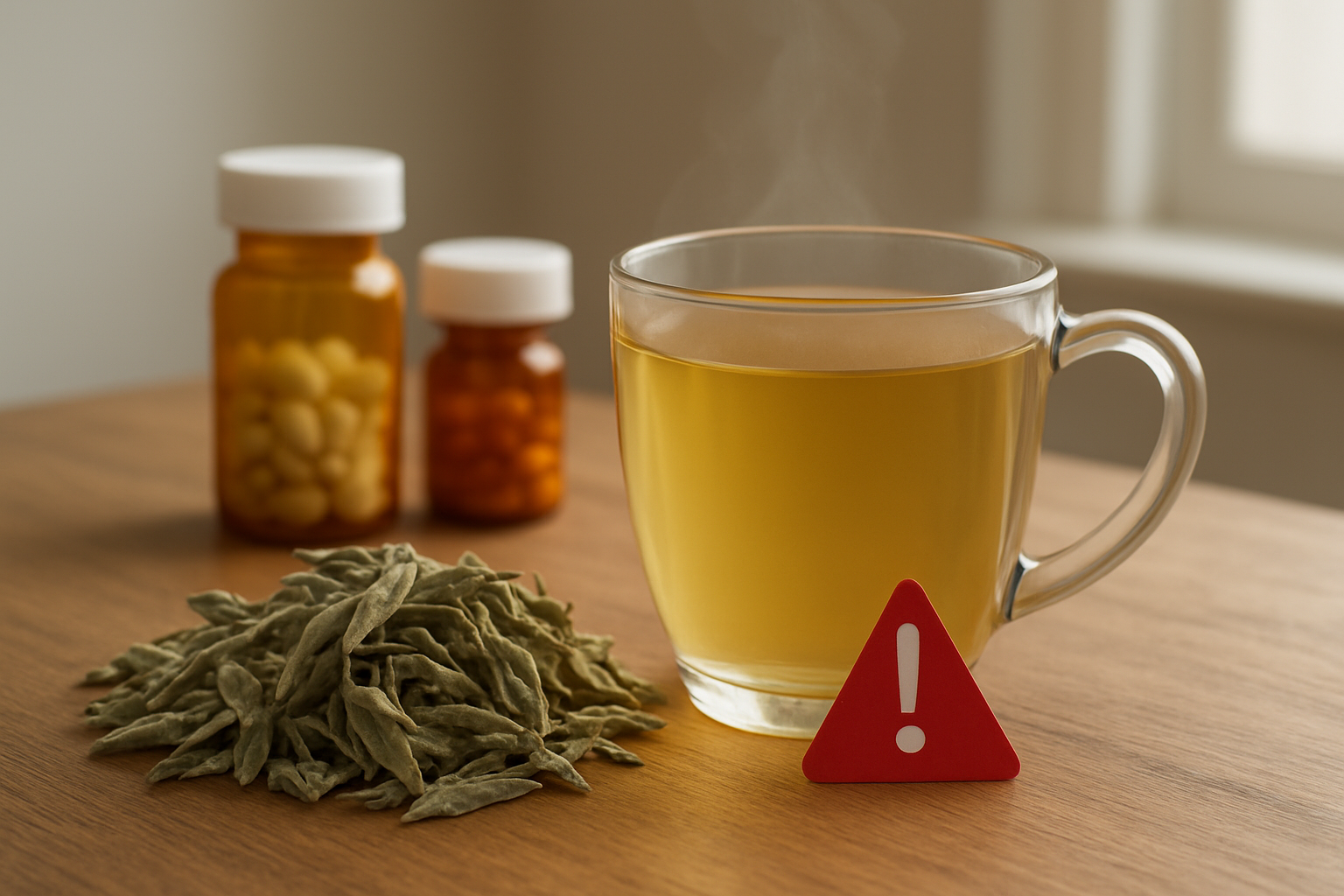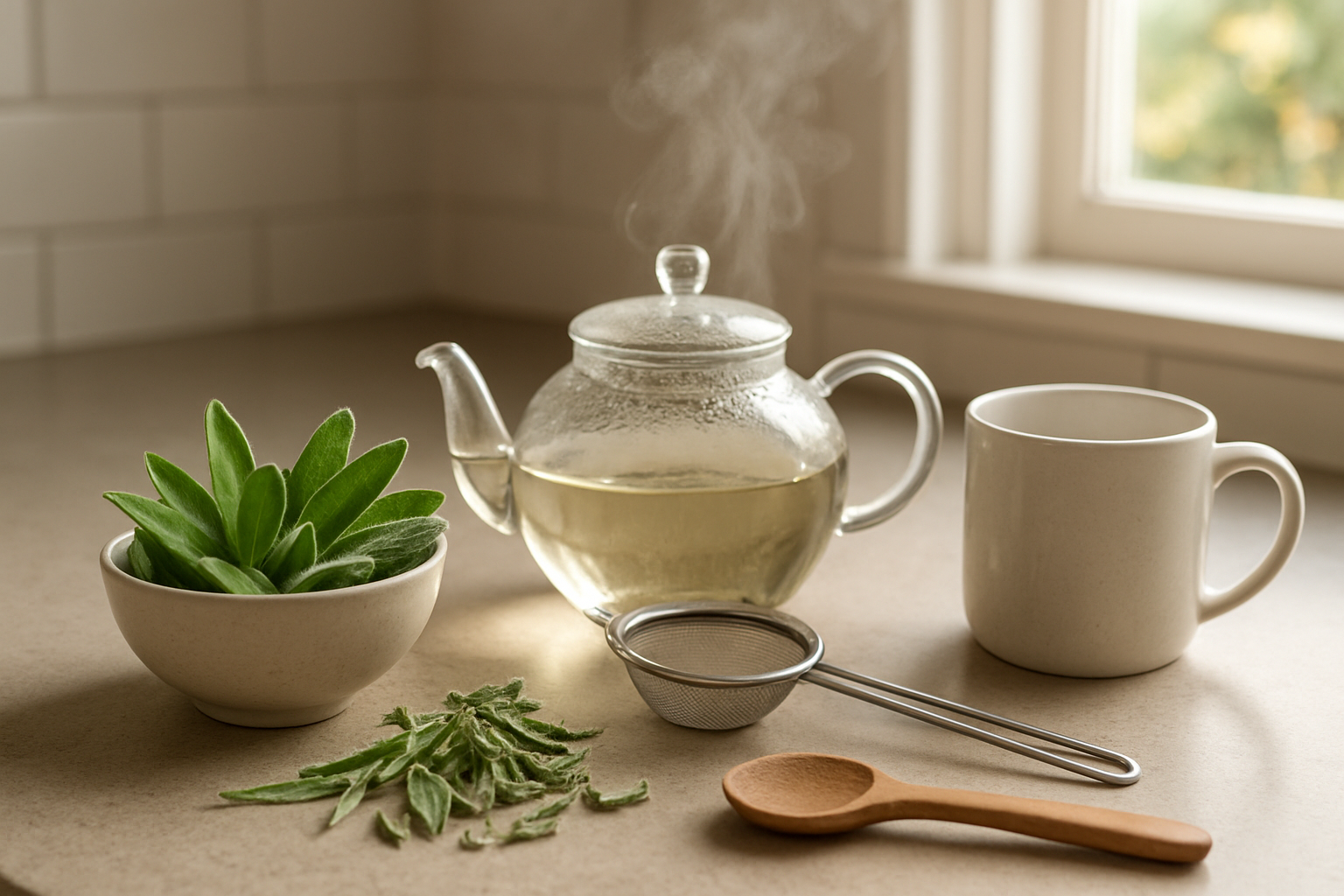Sage tea offers powerful health benefits backed by science, but knowing how to prepare it safely makes all the difference. This herbal remedy appeals to health-conscious individuals, tea enthusiasts, and anyone exploring natural wellness alternatives to support their daily routine.
You’ll discover the proven health benefits that make sage tea worth adding to your wellness toolkit. We’ll also cover the important safety considerations and potential risks you should know before brewing your first cup. Plus, you’ll get easy preparation methods that help you make the perfect cup every time.
Understanding Sage Tea and Its Origins

What Makes Sage Tea a Powerful Herbal Remedy
Sage tea stands out among herbal remedies due to its impressive concentration of bioactive compounds that work together to create meaningful health effects. The leaves of Salvia officinalis contain over 160 different polyphenolic compounds, including rosmarinic acid, carnosic acid, and salvianolic acids. These antioxidants give sage tea its distinctive ability to combat free radicals and reduce inflammation throughout the body.
The essential oils in sage leaves contribute significantly to the tea’s therapeutic properties. Compounds like thujone, camphor, and 1,8-cineole provide antimicrobial and cognitive-enhancing effects. When steeped in hot water, these oils release their aromatic compounds, creating a tea that not only tastes distinctive but also delivers measurable health benefits.
Sage’s power also comes from its tannins, which give the tea its slightly astringent taste and contribute to its ability to soothe digestive issues and reduce inflammation in mucous membranes. The combination of volatile oils, phenolic acids, and flavonoids creates a synergistic effect that amplifies the individual benefits of each compound.
What makes sage particularly interesting is its ability to cross the blood-brain barrier, allowing its active compounds to directly influence brain function. This explains why sage tea has been valued for memory enhancement and cognitive support across different cultures for thousands of years.
Traditional Uses Across Different Cultures
Mediterranean cultures have embraced sage as a cornerstone of traditional medicine for over 2,000 years. Ancient Romans considered sage so valuable that they called it “salvia,” meaning “to heal” or “to save.” Roman physicians prescribed sage tea for digestive complaints, wound healing, and memory enhancement. Greek healers used it as a general tonic and believed it could extend life span.
Native American tribes, particularly in the southwestern United States, have used white sage (Salvia apiana) in ceremonial practices and as a medicinal tea for respiratory issues, digestive problems, and spiritual cleansing. The Lakota, Cherokee, and other tribes burned sage for purification rituals while brewing the leaves into teas for treating colds, fever, and stomach ailments.
Chinese traditional medicine incorporates red sage (Salvia miltiorrhiza) into herbal formulations, often brewing it as tea to support cardiovascular health and improve circulation. Practitioners in Traditional Chinese Medicine view sage as having cooling properties that can calm excessive heat in the body and restore balance.
European folk medicine traditions have long relied on sage tea for women’s health issues, particularly for reducing hot flashes and night sweats. German herbalists traditionally recommended sage tea for excessive sweating, throat infections, and digestive disturbances. British herbalists used it as a gargle for sore throats and as a tea for improving mental clarity.
Middle Eastern cultures have incorporated sage into their daily tea rituals, often combining it with other herbs like mint or chamomile. In these traditions, sage tea serves both as a daily wellness drink and as a remedy for common ailments like indigestion and respiratory congestion.
Different Types of Sage for Tea Making
Common sage (Salvia officinalis) represents the most widely used variety for tea making and offers the strongest therapeutic benefits. This Mediterranean native produces gray-green leaves with a robust, slightly bitter flavor that becomes more complex when dried and steeped. Garden sage contains the highest concentrations of beneficial compounds like rosmarinic acid and essential oils, making it the gold standard for medicinal sage teas.
White sage (Salvia apiana) grows primarily in California and northwestern Mexico, producing silvery-white leaves with a more intense, almost medicinal flavor. While traditionally used by Native Americans for ceremonial purposes, white sage makes a potent tea with strong antimicrobial properties. The flavor can be overwhelming for beginners, so many people start with smaller amounts or blend it with milder herbs.
Clary sage (Salvia sclarea) offers a sweeter, more floral profile compared to common sage. The leaves produce a gentler tea that many people find more palatable, especially those sensitive to the strong taste of traditional sage. Clary sage tea has been particularly valued for women’s health and hormonal balance.
Pineapple sage (Salvia elegans) brings a fruity twist to sage tea with its distinctive pineapple aroma and flavor. This variety contains different essential oil profiles that create a more pleasant drinking experience while still providing antioxidant benefits. Many people use pineapple sage as a gateway to developing a taste for stronger sage varieties.
Greek sage (Salvia fruticosa) grows wild throughout the Mediterranean and produces leaves with a more intense flavor than common sage. This variety has been specifically studied for its cognitive benefits and contains unique compounds that may enhance memory and mental clarity more effectively than other sage types.
Red sage (Salvia miltiorrhiza), also known as Danshen in Chinese medicine, offers different therapeutic compounds compared to other varieties. While less commonly used for casual tea drinking due to its strong medicinal taste, red sage provides specific cardiovascular benefits and is often combined with other herbs to improve palatability.
Science-Backed Health Benefits of Sage Tea

Cognitive Enhancement and Memory Support
Multiple studies have shown that sage tea contains compounds called acetylcholinesterase inhibitors, which help preserve brain chemicals essential for memory formation. Research published in pharmacological journals demonstrates that regular sage consumption can improve working memory and attention span in both healthy adults and those experiencing age-related cognitive decline.
The rosmarinic acid in sage crosses the blood-brain barrier effectively, providing direct neuroprotective benefits. Clinical trials involving elderly participants found that those drinking sage tea daily scored significantly higher on memory tests compared to control groups. The antioxidants in sage also protect brain cells from oxidative stress, which contributes to cognitive aging.
Students and professionals often report enhanced focus and mental clarity when incorporating sage tea into their daily routine. The herb’s natural compounds support neurotransmitter function, making it easier to concentrate during demanding mental tasks.
Digestive Health and Gut Wellness
Sage tea acts as a powerful digestive aid through several mechanisms. The herb’s bitter compounds stimulate digestive enzyme production, helping break down proteins and fats more efficiently. This natural digestive support can reduce bloating, gas, and indigestion after meals.
The antimicrobial properties of sage help maintain healthy gut bacteria balance. Studies show that sage’s essential oils can inhibit harmful bacteria growth while supporting beneficial microorganisms. This creates an optimal environment for nutrient absorption and overall digestive wellness.
Traditional herbalists have long recommended sage tea for stomach upset, and modern research supports this application. The herb’s anti-spasmodic properties calm digestive tract muscles, reducing cramping and discomfort. People with sensitive stomachs often find sage tea gentler than other herbal remedies.
Anti-Inflammatory Properties for Joint Health
The anti-inflammatory compounds in sage tea, particularly carnosic acid and rosmarinic acid, provide significant benefits for joint health. These bioactive substances work by inhibiting inflammatory pathways that contribute to joint pain and stiffness.
Regular sage tea consumption may help reduce markers of inflammation in the body, as demonstrated in several clinical studies. Participants drinking sage tea showed decreased levels of inflammatory proteins like C-reactive protein and interleukin-6, both linked to chronic inflammatory conditions.
People with arthritis or other joint conditions often report reduced morning stiffness and improved mobility when adding sage tea to their wellness routine. The herb’s antioxidant properties also protect cartilage from free radical damage, potentially slowing joint deterioration over time.
Hormonal Balance Support for Women
Sage tea offers unique benefits for women’s hormonal health, particularly during menopause. The phytoestrogens in sage can help moderate hormonal fluctuations, reducing the intensity of hot flashes and night sweats. Clinical research shows that women drinking sage tea experience up to 64% fewer hot flashes within eight weeks.
The herb’s natural compounds also support healthy estrogen metabolism, helping the body process hormones more effectively. This can lead to improved mood stability, better sleep quality, and reduced hormonal acne in women of various ages.
Sage tea may also help regulate menstrual cycles by supporting the hypothalamic-pituitary axis, which controls hormone production. Women with irregular periods sometimes find that consistent sage tea consumption helps establish more predictable cycles, though individual results vary significantly.
Potential Risks and Safety Considerations

Dosage Guidelines to Avoid Adverse Effects
Sage tea’s potency means proper dosing is crucial for safety. Most herbalists recommend limiting consumption to 1-2 cups daily, using about 1 teaspoon of dried sage leaves per cup of water. This translates to roughly 2-4 grams of dried sage per day.
The concentration of compounds like thujone varies significantly between different sage varieties and preparation methods. Garden sage (Salvia officinalis) contains higher levels of potentially problematic compounds compared to other sage species. Drinking more than 3-4 cups daily or consuming highly concentrated sage preparations can lead to unwanted side effects including dizziness, rapid heartbeat, and digestive upset.
People new to sage tea should start with half a cup daily and gradually increase their intake while monitoring their body’s response. Taking breaks from regular consumption – perhaps drinking sage tea for 2-3 weeks followed by a week off – helps prevent compound buildup in the system.
Drug Interactions and Medical Contraindications
Sage contains compounds that can interfere with several medications and medical conditions. People taking diabetes medications need extra caution, as sage can lower blood sugar levels and potentially cause dangerous drops when combined with antidiabetic drugs. Regular blood sugar monitoring becomes essential for diabetics who want to include sage tea in their routine.
The herb also affects blood clotting mechanisms. Anyone taking anticoagulant medications like warfarin, heparin, or even daily aspirin should consult their healthcare provider before drinking sage tea regularly. The combination could increase bleeding risk, particularly concerning for upcoming surgeries or dental procedures.
Sage’s hormone-like effects make it problematic for people with hormone-sensitive conditions including breast cancer, ovarian cancer, endometriosis, and uterine fibroids. The plant contains compounds that may mimic estrogen activity, potentially worsening these conditions.
People with seizure disorders should avoid sage tea entirely. The thujone content can lower seizure thresholds, making episodes more likely even in well-controlled epilepsy cases.
Special Precautions for Pregnancy and Breastfeeding
Pregnant women should completely avoid sage tea throughout all trimesters. The herb contains compounds that can stimulate uterine contractions, potentially triggering miscarriage or premature labor. Even small amounts pose risks, as sage’s active compounds cross the placental barrier and can affect fetal development.
The thujone content presents additional concerns during pregnancy. This compound can be neurotoxic to developing babies and may interfere with normal brain development. Some traditional cultures have historically used sage to induce menstruation or terminate pregnancies, highlighting its potent uterine effects.
Breastfeeding mothers face different but equally important concerns. Sage actually reduces milk production by suppressing prolactin, the hormone responsible for milk synthesis. This anti-galactagogue effect has been used traditionally to wean babies, but it can severely impact milk supply for mothers who want to continue breastfeeding.
Even occasional sage tea consumption while nursing can decrease milk output within hours. The compounds pass into breast milk and may affect the baby’s developing nervous system. Many lactation consultants recommend avoiding all sage products, including culinary amounts, during the breastfeeding period.
Women planning to become pregnant should also exercise caution, as sage’s effects on hormone levels and menstrual cycles could interfere with conception efforts.
Step-by-Step Sage Tea Preparation Methods

Fresh Sage Leaves Tea Recipe
Using fresh sage leaves creates the most aromatic and potent tea experience. Start by selecting 8-10 unblemished sage leaves from your garden or store-bought organic sage. Rinse the leaves gently under cool water and pat them dry with a clean kitchen towel. The key is to bruise the leaves slightly to release their essential oils – simply roll them between your palms or give them a gentle twist.
Place the prepared leaves in your teapot or directly into your cup. Pour hot water (around 200°F) over the leaves, ensuring they’re completely submerged. The fresh leaves will float initially, which is perfectly normal. Cover your vessel to trap the steam and essential oils that would otherwise escape.
Fresh sage tea typically requires a longer steeping time than dried varieties because the cell walls in fresh leaves are tougher. Allow the tea to steep for 7-10 minutes for optimal flavor extraction. You’ll notice the water gradually changing to a beautiful golden-green color as the sage releases its compounds.
Dried Sage Tea Brewing Technique
Dried sage offers convenience and concentrated flavor, making it perfect for daily consumption. Use approximately 1 teaspoon of dried sage leaves per cup of water – this ratio ensures a well-balanced tea that’s neither too weak nor overwhelmingly strong.
Place the dried sage in a tea infuser, strainer, or directly in your teapot if you plan to strain later. The smaller particle size of dried sage means it will release its flavors more quickly than fresh leaves. Pour hot water over the dried sage, making sure to wet all the leaves evenly.
Dried sage requires less steeping time than fresh – typically 3-5 minutes produces the best results. Over-steeping dried sage can result in a bitter, overpowering taste that masks the herb’s natural complexity. If you prefer a stronger flavor, use more dried sage rather than extending the steeping time.
Optimal Steeping Time and Temperature Control
Temperature control makes the difference between a mediocre cup and an exceptional sage tea experience. The ideal water temperature ranges between 195°F and 205°F – just below boiling point. Water that’s too hot can destroy delicate compounds and create bitter notes, while cooler water won’t extract the beneficial compounds effectively.
If you don’t have a thermometer, bring water to a rolling boil, then let it cool for 30-60 seconds before pouring. This simple technique consistently achieves the right temperature range.
Steeping time varies based on your sage type and personal preference:
| Sage Type | Steeping Time | Water Temperature |
|---|---|---|
| Fresh leaves | 7-10 minutes | 200°F |
| Dried leaves | 3-5 minutes | 195-205°F |
| Ground sage | 2-3 minutes | 195°F |
Flavor Enhancement Tips and Natural Additions
Sage tea has a naturally earthy, slightly bitter flavor that pairs beautifully with various natural additions. Honey works exceptionally well, complementing sage’s herbal notes while adding natural sweetness. Add honey after steeping to preserve its beneficial enzymes – hot water can destroy these delicate compounds.
Lemon juice brightens the tea’s flavor profile and adds vitamin C. A squeeze of fresh lemon also helps your body absorb sage’s antioxidants more effectively. For a warming winter blend, add a cinnamon stick during steeping or a pinch of ground cinnamon.
Fresh mint leaves create a refreshing combination that’s particularly enjoyable iced. Add 2-3 mint leaves alongside your sage for a cooling effect. Ginger root (fresh or dried) pairs wonderfully with sage, creating a warming, digestive-supporting blend.
For those who enjoy floral notes, a teaspoon of dried lavender creates a calming evening tea. Apple slices added during steeping provide natural sweetness and complement sage’s earthy flavor. Experiment with these combinations to find your perfect sage tea blend.
Maximizing Benefits Through Proper Consumption

Best Times of Day to Drink Sage Tea
Your body’s natural rhythms play a big role in how well you absorb nutrients and process herbal compounds. Morning consumption, about 30 minutes after breakfast, helps your digestive system handle sage’s active compounds more effectively. The antioxidants in sage tea work best when your metabolism is naturally higher during the first half of the day.
Late afternoon, around 2-3 PM, represents another optimal window. This timing takes advantage of your body’s secondary metabolic peak while avoiding potential sleep disruption. Sage contains mild stimulating properties that can interfere with rest if consumed too close to bedtime.
Avoid drinking sage tea on an empty stomach, especially if you have sensitive digestion. The concentrated compounds can cause mild nausea in some people. Evening consumption should stop at least 4 hours before sleep to prevent any interference with your natural sleep cycle.
For women experiencing hormonal fluctuations, drinking sage tea during the first half of your menstrual cycle may provide better hormone-balancing effects. The phytoestrogens in sage align more effectively with your body’s natural estrogen patterns during this time.
Recommended Daily Intake for Optimal Results
Most research supports consuming 1-2 cups of sage tea daily for therapeutic benefits without risking side effects. Each cup should contain approximately 1 teaspoon of dried sage or 2 teaspoons of fresh leaves steeped for 5-10 minutes.
| Daily Intake | Dried Sage | Fresh Sage | Duration | Purpose |
|---|---|---|---|---|
| Light use | 0.5-1 tsp | 1-2 tsp | 3-5 minutes | General wellness |
| Moderate use | 1-2 tsp | 2-4 tsp | 5-8 minutes | Cognitive support |
| Therapeutic | 2-3 tsp | 4-6 tsp | 8-10 minutes | Specific health goals |
Cycling your consumption proves more effective than continuous daily use. Try drinking sage tea for 5 days, then taking a 2-day break. This prevents your body from developing tolerance to the active compounds and maintains the tea’s effectiveness over time.
People taking medications should start with half the recommended amount to assess their individual response. Blood sugar medications, hormone therapies, and seizure medications can interact with sage’s active compounds.
Pregnant and breastfeeding women should avoid sage tea entirely, as it contains compounds that can stimulate uterine contractions and reduce milk production.
Combining Sage Tea with Other Healthy Habits
Pairing sage tea with meditation or mindfulness practices amplifies its cognitive benefits. The act of slowly sipping warm tea naturally encourages mindful breathing and helps activate the relaxation response that sage compounds support.
Exercise timing matters when incorporating sage tea into your routine. Drinking a cup 30 minutes before light exercise enhances circulation and helps your body utilize sage’s anti-inflammatory compounds more effectively. Avoid consuming it immediately before intense workouts, as it may cause mild digestive discomfort.
Your diet can either enhance or diminish sage tea’s benefits. Foods rich in healthy fats like avocados, nuts, and olive oil help your body absorb fat-soluble compounds in sage. Vitamin C-rich foods consumed within an hour of drinking sage tea boost antioxidant absorption.
Creating a consistent routine strengthens the therapeutic effects. Many people find success combining sage tea with their morning journaling, afternoon reading break, or evening gentle stretching. The ritual itself becomes part of the healing process.
Stay well-hydrated throughout the day when drinking sage tea regularly. The diuretic properties can contribute to mild dehydration if you don’t maintain adequate water intake. Aim for at least 6-8 glasses of water daily in addition to your tea consumption.
Stress management techniques work synergistically with sage tea’s calming properties. Deep breathing exercises, gentle yoga, or even a few minutes of quiet reflection while drinking your tea can multiply the stress-reducing benefits.

Sage tea offers a compelling blend of traditional wisdom and modern science. From boosting cognitive function and supporting digestive health to providing antioxidant protection, this herbal beverage packs impressive health benefits that researchers continue to validate. The preparation is refreshingly simple—just steep fresh or dried sage leaves in hot water for 5-10 minutes, and you’ll have a flavorful tea ready to enjoy.
Remember to approach sage tea with balance and awareness. While it’s generally safe for most people, pregnant women, breastfeeding mothers, and those with certain medical conditions should exercise caution. Start with one cup daily and pay attention to how your body responds. Quality matters too, so choose organic sage when possible and store it properly to maintain its potent compounds. Ready to give this ancient remedy a try? Your next cup of sage tea could be the beginning of a simple yet meaningful addition to your daily wellness routine.














